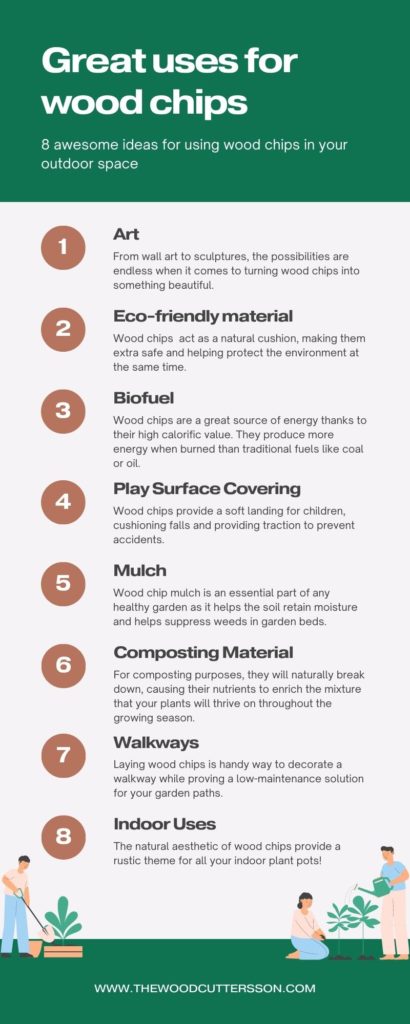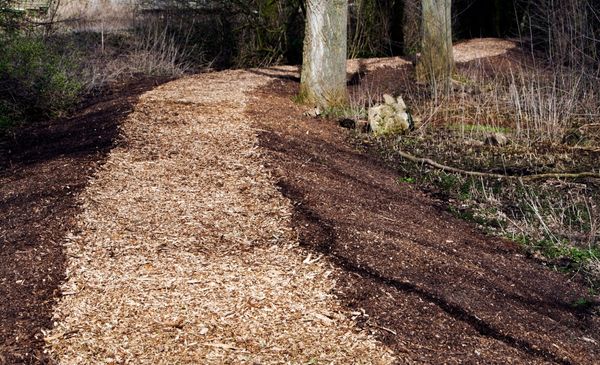Wood chips from a chipper can be a great resource for DIYers, gardeners, and woodworkers alike. But coming up with ideas of what to do with all those wood chips can be a challenge.
You might be tempted just to pitch them in the trash or leave them where they lie, but that would be a waste.
Luckily, there are plenty of creative ways to make use of the wood chips from your chipper. In this article, we’ll help you figure out exactly how to take those wood chips and put them to good use.
We’ll cover everything you need to know about what to do with your wood chips, including options for using them in the yard, around the house, and even as an art medium! Read on and get inspired!
TABLE OF CONTENTS:
What Are the Benefits of Wood Chips From a Chipper?
If you’re looking for a great way to add some natural beauty to your home, wood chips from a chipper are an excellent option. Not only do they look great, but they also provide a number of benefits you may not have considered.
Here’s a few good reasons why you should consider using wood chips in your outdoor space:
- Wood chips are cost-effective: Wood chips can be used as mulch or soil amendment and don’t require any costly fertilizers. This makes them an economical choice.
- Wood chips help retain moisture: By creating a barrier on top of the soil, wood chip mulch helps to keep moisture in the ground and encourage plants to grow more quickly.
- Wood chips protect plants from extreme temperatures: A layer of wood chips helps protect plants from frost in winter and intense heat in summer by keeping the soil at a more consistent temperature.
As well as their practical benefits, wood chips also create a stunning visual effect when used around gardens and other outdoor areas, making them an attractive option for any landscaping project.
8 Great Uses for wood chips [Infographic]

Are There Any Special Precautions Needed When Dealing With Wood Chips?
When it comes to dealing with wood chips, there are a few special precautions that you’ll want to keep in mind. After all, as with any other material, certain safety measures should always be taken.
Hazards
Wood chips can be hazardous if not handled properly. For example, they can become a fire hazard if left in direct sunlight or high temperatures for extended periods of time.
They can also be inhaled or ingested and may contain toxins or parasites that could cause health problems. Make sure the area around the wood chips is clear of any materials that may be combustible.
Related Article: Best wood chippers for home use
Protective Gear
It’s also important to wear protective gear when working with wood chips—gloves, goggles, and a dust mask are a must! In addition, wearing long sleeves and pants can help keep you safe from splinters.
Lastly, since wood chips are sharp in texture, make sure to wear closed-toe shoes before you start raking or shoveling them up!
With these potential hazards in mind, you can now begin your project worry-free. Just remember to practice proper safety precautions at all times during your work with wood chips!

What Are the Most Innovative Uses for Wood Chips From a Chipper?
You might be surprised to hear that there are some really cool and innovative uses for wood chips that you can get from a chipper. Here’s a quick look at some of them:
Wood chip use 1: Art
With a bit of creativity, you can use wood chips to make all sorts of interesting crafts. From wall art to sculptures, the possibilities are endless when it comes to turning wood chips into something beautiful.
You don’t even have to be an artist – there are plenty of tutorials online that can show you how to make creative things out of wood chips!
Check out this Pinterest page on wood chip crafts!
Wood chip use 2: Environmentally-friendly material
Wood chips can also be used as an environmentally-friendly material in gardens, walkways and playgrounds. They act as a natural cushion, making them extra safe and helping protect the environment at the same time.
Plus they help retain moisture in the soil and also add essential nutrients back into it as they break down over time.
Wood chip use 3: Biofuel
Wood chips are a great source of energy thanks to their high calorific value, which means they can produce more energy when burned than traditional fuels like coal or oil.
This makes them especially useful in settings such as remote camps and areas where power is limited or difficult to access – perfect for adventurers!
Wood chip use 4: Play Surface Covering
Wood chips are commonly used for ground covering in playgrounds and play spaces. Wood chips provide a soft landing for children, cushioning falls and providing traction to prevent accidents.
Wood chip use 5: Mulch
Wood chip mulch is an essential part of any healthy garden as it helps the soil retain moisture and helps suppress weeds in garden beds. Wood chips however, don’t provide necessary nutrients to plants and shrubs so it’s important to ensure you fertilize your garden appropriately.
Wood chip use 6: Composting Material
Wood chips are rich in carbon, and are a great addition to your soil. For composting purposes, they will naturally break down, causing their nutrients to enrich the mixture that your plants will thrive on throughout the growing season.
Wood chip use 7: Walkways
Wood chips can perform great as a cost-effective substrate for garden walkways. They correct uneven surfaces, and suppress weeds year-round. Laying wood chips is handy way to decorate a walkway while proving a low-maintenance solution for your garden paths.
Wood chip use 8: Indoor Uses
Wood chips can be used as a finisher in indoor vases as a decorative material. The natural aesthetic of wood chips provide a rustic theme for all your indoor plant pots!
Conclusion
Using wood chips from a chipper is a great way to add texture, color, and flavor to your landscaping and gardening projects. However, they don’t come without some challenges – they can have an unfavorable texture, be difficult to handle, and require regular maintenance.
By taking the time to understand the benefits and challenges of wood chips, you can make sure you get the most out of them with your DIY projects.
Consider the type of material you’ll need, how to get the right texture, and how to store and maintain your wood chips, and you’ll find that wood chips from a chipper are a great way to enhance any outdoor landscape.

Leave a Reply